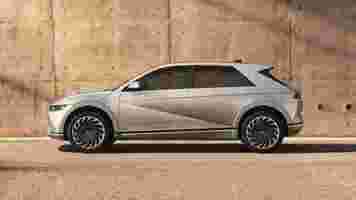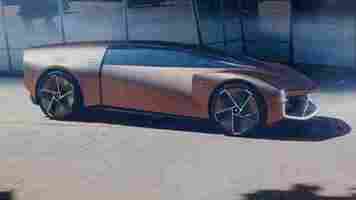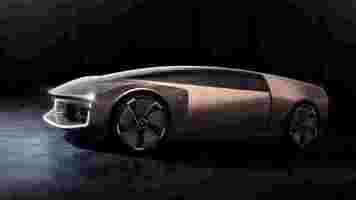3 things that make the Hyundai Ioniq 5 a great EV
Today, South Korean carmaker Hyundai unveiled its new hatchback EV, the 5. And you know what, it looks like a bloody brilliant.

The motoring media has already published plenty of lengthy write-ups, so I’m going to focus on just three things you need to know about this new car: its range, how fast it charges, and a unique feature that means it can power other devices.
But before we get to that, here’s a picture (lucky you) and quick overview.


Hyundai’s 5 is the company’s first EV that’s part of its new electric-focused Ioniq brand.
In August last year, Hyundai announced that it was broadening its EV offering and would do so under the Ioniq name , which so far has been the name of one of the brand’s EVs. With that in mind, the 5 lays down the foundation of what’s to come for Ioniq’s electric future.
It looks compact and like a hatchback, but Hyundai is adamant that it’s a crossover. In fact, it’s so long and wide that it gives the Hyundai Sante Fe SUV a run for its money.
From my point of view, it looks like a Cybertruck and a Lancia Delta Integrale of the late 1980s had a child. That’s no bad thing, it’s angular, and brutishly handsome.
It’ll come in 2WD (rear-wheel drive) or four-wheel drive. There will also be long-range and standard range versions, the American long-range version gets a 77.4 kWh battery pack, the rest of the world will get a 72.6 kWh battery.
Range
Here’s where we get on to perhaps the 5’s most important feature: its range.
With the 72.6 kWh long-range battery, the 5 will be capable of driving up to 300 miles on one full charge.
For a vehicle of this size, that’s not too bad. It brings the challenge to EVs like the Ford Mustang Mach-E, and the VW ID.4. With many EVs now hitting the 200-mile mark quite easily , 300 miles of range is likely to become the new benchmark, and the 5 is already there.
What’s more, the 5 can charge, bloody quick, too.
Fast-charging
In fact, if the Ioniq 5 was on sale today it would be one of the fastest, if not the fastest, charging EVs on the planet.
According to Hyundai, the 5 can charge from 10% to 80% in just 18 minutes when using a 350 kW charger. Sure, there aren’t many of those around right now, but being able to charge this fast puts it in the same league as the Porsche Taycan.
Now, let’s be honest, we’ve never lived in a world where we can make a serious comparison between a Hyundai and a Porsche. What a time to be alive.
Bidirectional charging
But that’s not all. The Hyundai Ioniq 5’s best feature is its vehicle-to-load charging feature. In normal people speak, the V2L feature is a type of bidirectional charging which lets drivers recharge or power other electronics like ebikes, laptops, TVs, fridges, and so on, directly from the vehicle.
There’s a plug socket inside the vehicle for smaller electronics, and an adaptor outside that can be used in the car ’s regular charge port to power pretty much anything — well, as long as it doesn’t draw more than 3.6 kW of power .
It’s not vehicle-to-grid charging, so you can’t power your home from this, but it’s close.
Y’know, just yesterday I wrote about vehicle-to-grid charging and how i t could be a lifeline for those experiencing power outages because of adverse weather.
Hopefully, Hyundai’s V2L system is a sign that fully fledged V2G hardware is on the way. It’s the next logical step for this technology and Hyundai should definitely make it happen.
V2G tech can help secure energy, reduce load on local grids, and provide support in times of emergency. Get on it, Hyundai.
SHIFT is brought to you by Polestar. It’s time to accelerate the shift to sustainable mobility. That is why Polestar combines electric driving with cutting-edge design and thrilling performance. Find out how .
Teorema’s virtual concept car has got weird-ass doors… and I love it
The Italian historic coachbuilder Pininfarina may have stopped designing cars for Ferrari, but has sure been busy lately.

Just two weeks ago, the firm announced it’s going to create a 1000hp electric truck for the EV startup Hercules, and on Wednesday revealed its utterly sleek Teorema concept .


The Teorema is Pininfarina’s first 100% virtually developed concept car and aims to offer “an all-new interpretation of fully electric, autonomous mobility.”
Designed inside out
The design teams in Cambiano and Shanghai created the interior experience before developing the exterior, starting from a scalable electric skateboard chassis which allows the car to maximize in-cabin space.
Passengers sit in a space shaped like a pentagon, while the driver — if they choose an active driving mode — sits alone up front in a central seating position, which can also be turned around to face the occupants.
Since the Teorema doesn’t have doors on the sides, passengers can also convert the four chairs into benches, where they can rest or even sleep.
To enter, “they simply walk inside” as the rear opens and the roof extends upward and forward.
Multiple driving modes
The Teorema is completely autonomous requiring, therefore, no driver on the wheel. On top of that, it features three driving modes that create a different space experience.
Autonomy mode: the driver faces the other passengers, with enough distance between them to create a feeling of a “private cocoon.”
Drive mode: the different areas of the vehicle acquire the same color to boost a “community feeling.”
Rest mode: the passengers can move to any position, and the interior is transformed into a “social space.”
Augmented reality
Behind the car’s windshield and side glasses appear virtual images, aligned with real-world data, that inform passengers about “relevant traffic information, places of interest, and curiosities.” Passengers can interact with the displayed information and choose to learn more or share it with the other occupants.
Unfortunately, Pininfarina doesn’t typically build cars itself, so it’s highly unlikely that the Teorema will ever reach production. Instead, it manifests the firm’s design expertise and previews how it will approach its future creations.
Well, I don’t know about you, but if that’s indeed the future of electric autonomous mobility, I’m sold!
Do EVs excite your electrons? Do ebikes get your wheels spinning? Do self-driving cars get you all charged up?
Then you need the weekly SHIFT newsletter in your life. Click here to sign up .
DHL wants to build the world’s first electric air cargo network
DHL Express is teaming up with all-electric aircraft manufacturer Eviation to build the world’s first electric air cargo network.

On Tuesday, the courier giant announced the order of twelve “Alice” aircraft from the Seattle-based company to be delivered by 2024.
Alice is an all-electric nine-seat aircraft, designed to transport passengers and freight alike.
It can be flown by a single pilot and carry up to 1,200kg of payload. It needs a mere 30-minute charge per flight hour, and has a maximum range of up to 815 kilometers.
Eviation, which expects to make Alice’s maiden flight later this year, is one of a number of companies looking to electrify regional air travel and reduce energy consumption, operating costs, and CO2 emissions.
To name a few examples, there are also Sweden’s Heart Aerospace and Italy’s Tecnam .
Regarding the partnership with Eviation, John Pearson, CEO of DHL Express, said:
Plus, DHL is interested in some practical advantages that Alice offers: it requires less investment in station infrastructure and can be charged while loading and unloading.
As per the German firm, this makes Alice ideal for feeder routes and for the tight schedules, which need to be maintained.
This collaboration is part of the Deutsche Post DHL Group’s $8.3 billion investment in measures to reduce emissions by 2030 and to go carbon-free by 2050.
Do EVs excite your electrons? Do ebikes get your wheels spinning? Do self-driving cars get you all charged up?
Then you need the weekly SHIFT newsletter in your life. Click here to sign up .